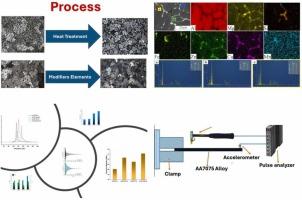提高Al-Zn-Mg-Cu基铝合金力学和动态性能:显微组织改性和热处理相结合的方法
IF 6.3
2区 材料科学
Q2 CHEMISTRY, PHYSICAL
引用次数: 0
摘要
本研究研究了添加Ti、B、Ni和Cr合金元素的显微组织改性以及热处理、均匀化和固溶(T6)对Al-Zn-Mg-Cu基铝合金力学和动态性能的综合影响。铸态合金在470°C下均匀化3 h,在470°C下空冷固溶3 h,淬火,然后在120°C下人工时效24 h。SEM分析证实,与未改性的合金相比,改性后的Al-Zn-Mg-Cu基合金的显微组织得到了改善,尤其是在T6处理后。T6热处理通过溶解金属间相析出和弥散体改善组织,随后淬火时效促进强化相析出。与铸态相比,改进合金的抗拉强度提高了11.4%,伸长率提高了40%。与Al-Zn-Mg-Cu基合金相比,改进合金的动态杨氏模量提高了13.0%。改性和回火的协同作用对动态特性的改善最为显著;与未改性合金相比,改性合金的第一模谐振频率提高了11.5%,动态模量提高了25.4%。回火改性合金(Al-Zn-Mg-Cu基- m - t6)的阻尼比优于均质改性合金。这表明回火产生的析出相与变质引起的位错之间存在相关性。本文章由计算机程序翻译,如有差异,请以英文原文为准。

Improving the mechanical and dynamic properties of Al-Zn-Mg-Cu- based aluminum alloy: A combined approach of microstructural modification and heat treatment
This study investigates the combined effects of microstructural modification by adding Ti, B, Ni, and Cr alloying elements and heat treatment, homogenization and solid solution (T6), on the mechanical and dynamic properties of Al-Zn-Mg-Cu- based aluminum alloy. The cast alloys were homogenized at 470 °C for 3 h, air cooled and solid solved at 470 °C for 3 h, quenched, and then artificial aged at 120 °C for 24 h. The modified Al-Zn-Mg-Cu- based alloy consistently shows an improved microstructure compared to the unmodified alloy, especially after T6 treatment, as confirmed by SEM analysis. The T6 heat treatment improved the microstructure by dissolving intermetallic phase precipitates and dispersoids, followed by quenching and aging to promote the precipitation of strengthening phases. The improved alloy exhibited 11.4 % enhancement in ultimate tensile strength and a 40 % improvement in elongation compared to the as-cast version. Furthermore, the dynamic young’s modulus of the improved alloy was enhanced by 13.0 % relative to Al-Zn-Mg-Cu- based alloy. The synergistic impact of modification and tempering resulted in the most significant enhancement in dynamic characteristics; thus, the modified alloy exhibited an increase of 11.5 % in first-mode resonant frequency and 25.4 % in dynamic modulus relative to the unmodified alloy. The tempered modified alloy (Al-Zn-Mg-Cu- based -M-T6) exhibits a somewhat superior damping ratio compared to the modified and homogenized alloy. This indicates a correlation between precipitated phases created by tempering and dislocations caused by modification.
求助全文
通过发布文献求助,成功后即可免费获取论文全文。
去求助
来源期刊

Journal of Alloys and Compounds
工程技术-材料科学:综合
CiteScore
11.10
自引率
14.50%
发文量
5146
审稿时长
67 days
期刊介绍:
The Journal of Alloys and Compounds is intended to serve as an international medium for the publication of work on solid materials comprising compounds as well as alloys. Its great strength lies in the diversity of discipline which it encompasses, drawing together results from materials science, solid-state chemistry and physics.
 求助内容:
求助内容: 应助结果提醒方式:
应助结果提醒方式:


